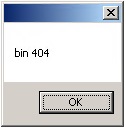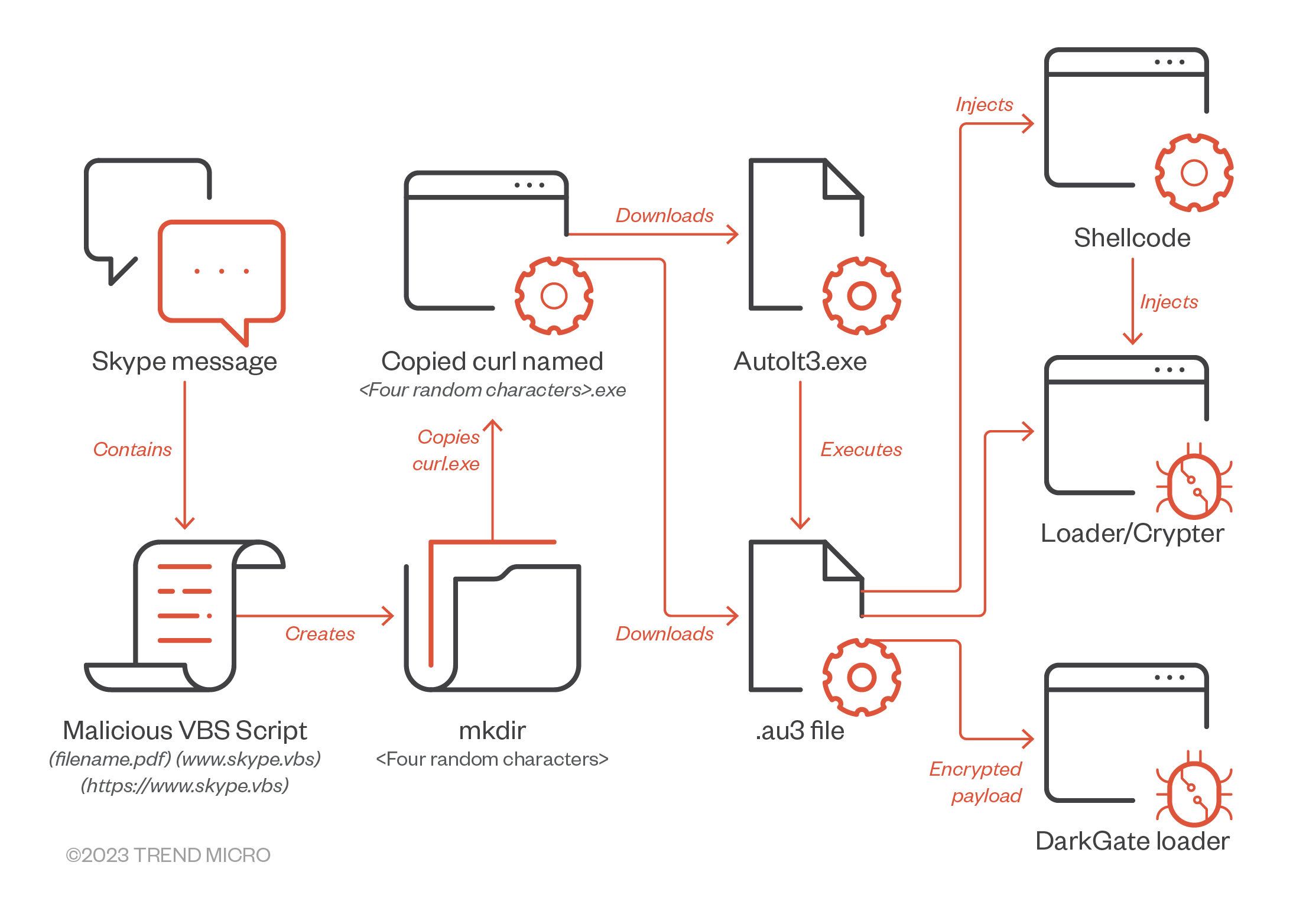TrojanSpy.AutoIt.DARKGATE.AA
Windows


Threat Type: Trojan Spy
Destructiveness: No
Encrypted: Yes
In the wild: Yes
OVERVIEW
This Trojan Spy arrives on a system as a file dropped by other malware or as a file downloaded unknowingly by users when visiting malicious sites.
It executes commands from a remote malicious user, effectively compromising the affected system.
It logs a user's keystrokes to steal information.
TECHNICAL DETAILS
Arrival Details
This Trojan Spy arrives on a system as a file dropped by other malware or as a file downloaded unknowingly by users when visiting malicious sites.
Installation
This Trojan Spy drops the following files:
- %System Root%\temp\AutoIt3.exe
- %System Root%\temp\{7 Characters Generated for "au3file"}.au3
- %ProgramData%\{7 Characters Generated for "mainfolder"}\AutoIt3.exe
- %ProgramData%\{7 Characters Generated for "mainfolder"}\{7 Characters Generated for "au3file"}.au3
- %ProgramData%\{7 Characters Generated for "mainfolder"}\{7 Characters Generated for "logsfolder"}\{7 Characters Generated for "settings"} ← Encrypted malware settings
- %ProgramData%\{7 Characters Generated for "mainfolder"}\{7 Characters Generated for "logsfolder"}\{DD-MM-YYYY}.log ← Encrypted keylogs and clipboard data
(Note: %System Root% is the Windows root folder, where it usually is C:\ on all Windows operating system versions.. %ProgramData% is a version of the Program Files folder where any user on a multi-user computer can make changes to programs. This contains application data for all users. This is usually C:\ProgramData on Windows Vista, 7, 8, 8.1, 2008(64-bit), 2012(64-bit) and 10(64-bit), or C:\Documents and Settings\All Users on Windows Server 2003(32-bit), 2000(32-bit) and XP.)
It creates the following folders:
- %System Root%\temp
- %ProgramData%\{7 Characters Generated for "mainfolder"}
- %ProgramData%\{7 Characters Generated for "mainfolder"}\{7 Characters Generated for "logsfolder"}
- %User Temp%\{7 Characters Generated for "supertemp"}
(Note: %System Root% is the Windows root folder, where it usually is C:\ on all Windows operating system versions.. %ProgramData% is a version of the Program Files folder where any user on a multi-user computer can make changes to programs. This contains application data for all users. This is usually C:\ProgramData on Windows Vista, 7, 8, 8.1, 2008(64-bit), 2012(64-bit) and 10(64-bit), or C:\Documents and Settings\All Users on Windows Server 2003(32-bit), 2000(32-bit) and XP.. %User Temp% is the current user's Temp folder, which is usually C:\Documents and Settings\{user name}\Local Settings\Temp on Windows 2000(32-bit), XP, and Server 2003(32-bit), or C:\Users\{user name}\AppData\Local\Temp on Windows Vista, 7, 8, 8.1, 2008(64-bit), 2012(64-bit) and 10(64-bit).)
Autostart Technique
This Trojan Spy drops the following file(s) in the Windows User Startup folder to enable its automatic execution at every system startup:
- %User Startup%\{7 Characters Generated for the LNK file}.lnk
(Note: %User Startup% is the current user's Startup folder, which is usually C:\Windows\Profiles\{user name}\Start Menu\Programs\Startup on Windows 98 and ME, C:\WINNT\Profiles\{user name}\Start Menu\Programs\Startup on Windows NT, C:\Documents and Settings\{User name}\Start Menu\Programs\Startup on Windows 2003(32-bit), XP and 2000(32-bit), or C:\Users\{user name}\AppData\Roaming\Microsoft\Windows\Start Menu\Programs\Startup on Windows Vista, 7, 8, 8.1, 2008(64-bit), 2012(64-bit), 10(64-bit).)
Other System Modifications
This Trojan Spy modifies the following registry entries:
HKEY_CURRENT_USER\Software\Microsoft\
Windows\Windows Error Reporting
DontShowUI = 1
Backdoor Routine
This Trojan Spy executes the following commands from a remote malicious user:
- Collect system information and other data
- Start or stop malware components, control malware settings
- Start, stop, and configure cryptominer
- Steal data from various programs and data sources
- Initiate hVNC connection, hAnydesk, remote desktop protocol, execute commands
- Steal browser data
- Browse directories and manage files
- Update the malware, download additional components
It connects to the following URL(s) to send and receive commands from a remote malicious user:
- http://{BLOCKED}vservicceoffice.net:80
Information Theft
This Trojan Spy gathers the following data:
- Language Code ID
- Username
- Computer name
- Parent process
- Number of seconds from the user’s last interaction with the PC
- Processor information
- Graphics information
- Total Physical Memory space in MB
- OS Information
- Admin privileges
- Malware start time
- Name of Antivirus found
- Malware version
- Port number
- Clipboard data
It logs a user's keystrokes to steal information.
Stolen Information
This Trojan Spy sends the gathered information via HTTP POST to the following URL:
- http://{BLOCKED}vservicceoffice.net:80
Other Details
This Trojan Spy does the following:
- It proceeds to its malicious routine if the following conditions are satisfied:
- Existence of %Program Files% directory
- Username is not SYSTEM
- Malware file has a .au3 extension
- It displays the following if there is no ".au3" file found:

- Starts a process to stay memory-resident by injecting code to the added process:
- C:\Program Files (x86)\{Path of a file with .exe extension}
- %System%\cmd.exe ← If C:\Program Files (x86) path does not exist or no .exe file was found
- It checks the following to identify Anti-Virus and Security Applications found in the system:
- Existence of the following directory:
- %ProgramData%\Bitdefender
- %Program Files%\Bitdefender
- %ProgramData%\AVAST
- %Program Files%\AVAST Software
- %ProgramData%\AVG
- %Program Files%\AVG
- %ProgramData%\Kaspersky Lab
- %Program Files% (x86)\Avira
- %Program Files% (x86)\IObit
- %Program Files%\Malwarebytes
- %Program Files% (x86)\F-Secure
- %Program Files%\Quick Heal
- %ProgramData%\Emsisoft
- %Program Files%\Malwarebytes
- Running process:
- egui
- ns.exe
- nis.exe
- nortonsecurity.exe
- smc.exe
- uiseagnt.exe
- mcshield.exe
- mcuicnt.exe
- bytefence.exe
- cis.exe
- mbam.exe
- vkise.exe
- superantispyware.exe
- totalav.exe
- qhsafetray.exe
- sdscan.exe
- psuaservice.exe
- Existence of the following directory:
SOLUTION
Step 1
Before doing any scans, Windows 7, Windows 8, Windows 8.1, and Windows 10 users must disable System Restore to allow full scanning of their computers.
Step 2
Note that not all files, folders, and registry keys and entries are installed on your computer during this malware's/spyware's/grayware's execution. This may be due to incomplete installation or other operating system conditions. If you do not find the same files/folders/registry information, please proceed to the next step.
Step 3
Restart in Safe Mode
Step 4
Restore this modified registry value
Important: Editing the Windows Registry incorrectly can lead to irreversible system malfunction. Please do this step only if you know how or you can ask assistance from your system administrator. Else, check this Microsoft article first before modifying your computer's registry.
- HKEY_CURRENT_USER\Software\Microsoft\Windows\Windows Error Reporting
- DontShowUI = 1
- DontShowUI = 0
Step 5
Search and delete this file
- %System Root%\temp\AutoIt3.exe
- %System Root%\temp\{7 Characters Generated for "au3file"}.au3
- %ProgramData%\{7 Characters Generated for "mainfolder"}\AutoIt3.exe
- %ProgramData%\{7 Characters Generated for "mainfolder"}\{7 Characters Generated for "au3file"}.au3
- %ProgramData%\{7 Characters Generated for "mainfolder"}\{7 Characters Generated for "logsfolder"}\{7 Characters Generated for "settings"}
- %ProgramData%\{7 Characters Generated for "mainfolder"}\{7 Characters Generated for "logsfolder"}\{DD-MM-YYYY}.log
- %User Startup%\{7 Characters Generated for the LNK file}.lnk
Step 6
Search and delete these folders
- %System Root%\temp
- %ProgramData%\{7 Characters Generated for "mainfolder"}
- %ProgramData%\{7 Characters Generated for "mainfolder"}\{7 Characters Generated for "logsfolder"}
- %User Temp%\{7 Characters Generated for "supertemp"}
Step 7
Restart in normal mode and scan your computer with your Trend Micro product for files detected as TrojanSpy.AutoIt.DARKGATE.AA. If the detected files have already been cleaned, deleted, or quarantined by your Trend Micro product, no further step is required. You may opt to simply delete the quarantined files. Please check this Knowledge Base page for more information.
Did this description help? Tell us how we did.



